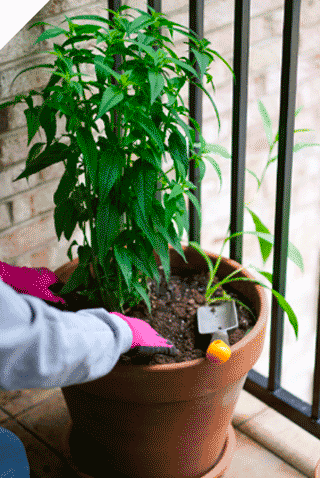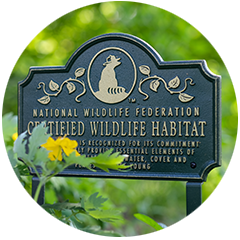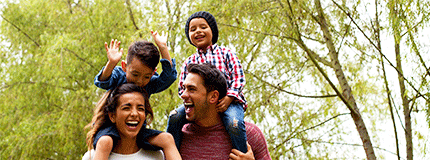Providing essential wildlife habitat doesn’t have to take acres— it can even be done in a small container garden! Read up on our tips for creating a native plant container garden, perfect for anyone with a balcony, deck, courtyard, or window boxes!
Choosing the Containers
Many native plants have deeper root systems than most commercially available non-native plants, so choosing large and deep containers will be your best bet. Large containers are also a good choice if you’re planning on overwintering your plants.
The material of your pots can also have a big impact on your garden. Porous material like ceramic and terracotta will allow water to evaporate more quickly. This can be helpful to avoid mold if you’re in a wet climate, but in hotter and drier areas, it can mean you need to water your plants more often! By contrast, a recycled plastic or metal container will better prevent water loss and can be a more lightweight option if you plan to regularly move the pots around or even hang them on a railing that has a weight restriction.
Ultimately, we recommend you use a combination of many planters in your container garden. The more containers you have, the more native plants you can include! Plus, you can use various sizes, heights, and styles of pots which add visual interest.

PLANTING NATIVE BEE BALM AND ASTERS IN A TERRACOTTA POT. PHOTO CREDIT: TESS RENUSCH
Selecting Native Plants
Selecting native plants for a container garden requires a few considerations. Don’t let this scare you off, though! By keeping the following tips in mind, you can find many native plants that suit your needs.
Container-Friendly Native Plants
Browse through our selection of native plant genera that do well in containers. Click on the plant names or use our Native Plant Finder to discover if these plants are native to your region!
Milkweed
Monarch caterpillars depend on milkweed and these milkweed species are great choices for planting in containers due to their shallower root systems.
- Swamp Milkweed (Asclepias incarnata)
- Whorled Milkweed (Asclepias verticillata)
- Butterfly Weed (Asclepias tuberosa)
Asters
These flowers can bring some beautiful blues and whites into your container garden. Many of these species can provide a source of late summer and even fall blooms for pollinators!
- New England Aster (Symphyotrichum novae-angliae)
- Blue Wood Aster (Symphyotrichum cordifolium)
- White Heath Aster (Symphyotrichum ericoides)
- Pacific Aster (Symphyotrichum chilense)
Coreopsis
These happy, yellow coreopsis flowers are great for attracting pollinators during the early summer when they bloom.
- Lanceleaf Coreopsis (Coreopsis lanceolata)
- Prairie Coreopsis (Coreopsis palmata)
Rudbeckia
There are many species of rudbeckia that do well in containers. They are beneficial for pollinators with their mid-to-late summer blooms.
- Black-Eyed Susan (Rudbeckia hirta)
- Cutleaf Coneflower (Rudbeckia laciniata)
- Brown-Eyed Susan (Rudbeckia triloba)
Coneflowers
Many plant sellers offer one or more varieties of native coneflowers. The blooms are great for pollinators and the seedheads are enjoyed by birds.
- Purple Coneflower (Echinacea purpurea)
Phlox
Certain native phlox species, like creeping phlox, grow low and can even cascade over the edges of your pots, adding beautiful visual interest with their purple blooms.
- Creeping Phlox (Phlox stolonifera)
- Wild Blue Phlox (Phlox divaricata)
Lobelia
These tall, tube-shaped flowers are great for pollinators, especially hummingbirds!
- Cardinal Flower (Lobelia cardinalis)
- Great Blue Lobelia (Lobelia siphilitica)
Monarda
This mint-family native has showy, bright blooms and can add some height to your containers. Pollinators, including bees, love their blooms!
- Wild Bergamot (Monarda fistulosa)
Ferns
These are a great choice for shadier areas in your container garden or as added greenery in your flowerpots.
- Christmas Fern (Polystichum acrostichoides)
- Cinnamon Fern (Osmundastrum cinnamomeum)
- Maidenhair Fern (Adiantum pedatum)
Grasses
These are great for adding greenery and texture into your container garden.
- Little Bluestem (Schizachyrium scoparium)
- Prairie Dropseed (Sporobolus heterolepis)
- Soft Rush (Juncus effusus)
Cacti, Succulents, and Desert Plants
Many cacti and desert plants do well in pots and can add great texture and blooms to a garden!
- Prairie Plantain (Plantago elongata)
- Many native dudleya species including Chalk Dudleya (Dudleya pulverulenta)
- Many native sedum species including Broadleaf Stonecrop (Sedum spathulifolium)
You can even find container garden plant selections to ship directly to your home from Garden for Wildlife!
For Extra Wildlife Benefit, Plant Multi-Season Blooms
Pollinators depend on a regular source of blooming flowers. To provide the most benefit for these wildlife species, select a variety of native plants that have different bloom times. This helps ensure there is always something blooming in your container garden for the pollinators!
A Note on Overwintering Plants and Hardiness Zones
Many native plants are perennials, meaning that they grow for multiple years and can overwinter. This is different from a lot of standard container garden non-native plants that you find in big box stores, which are expected to survive one year (or even just one season) and then to be discarded! Planting perennial native plants in your containers is not only possible but it can help save you money and reduce garden waste year after year!
However, since containers of soil do not maintain heat as well through the winter as the ground itself, you will need to select native plants that can withstand at least two hardiness zones colder than your zone (to do this simple math, take your local hardiness zone and subtract 2). This does not mean you need to plant species that are non-native to your region, instead it means that you should look for plant species native to you that have a wide hardiness region that extends at least two hardiness zones past your own.
You may also consider moving any containers closer to the building walls throughout winter to better absorb any heat from the building. Using mulch on top of the pot’s soil can also help retain heat and moisture. Fallen leaves can be a great option for this!

For example:
If you lived in Indiana in Hardiness Zone 6, you would be looking for native plants that can withstand a hardiness zone up to Zone 4.
In this situation, the gardener could plant purple coneflower, which is native to their region and has a hardiness zone rating of 3-9! This means that this plant should be well-equipped to overwinter in a large container in this region.
Keep Sun Availability in Mind
Some balconies and urban gardens can have limited sunshine due to the presence of a roof or simply tall surrounding buildings. Before selecting your plants, take a few sunny days to visit your container garden location and figure out how many hours of direct sun it receives. Even the shadiest of spots can host a great wildlife-friendly container garden, you just may need to stick to shade-loving plants like native ferns!
Full Sun: Over 6 hours of direct sunlight
Part Sun/Part Shade: 3-6 hours of direct sunlight
Shade: Less than 3 hours of direct sunlight

NATIVE BUTTERFLY WEED PLANTED IN A HANGING PLANTER. PHOTO CREDIT: TESS RENUSCH
Selecting Soil
There are many options for potting soils that can work well for your native plants. Selecting an organic potting soil option is a more sustainable choice for your garden and can even count as one of your sustainable gardening practices requirements to help you achieve a Certified Wildlife Habitat® recognition!
Don’t Be Afraid to Plant Vertically
The benefit of container gardening is that you’re not just limited to planting straight into the earth. Get creative and find ways to use your vertical space!
Try out window boxes, hanging baskets, and even shelves to maximize your outdoor space. Lots of wildlife that will benefit from these plants can fly or climb to your vertical garden spaces.
Watering
Lots of factors will determine how often you need to water your plants, including: the size and material of your containers, the sunniness of your location, the temperature, and even the plant species themselves. One thing to keep in mind is that plants in containers will often need more water than plants in the ground.
Get to know your plants and how damp the soil needs to be to keep them healthy. Some plants are more prone to mold and fungus issues that come with damp soil, while others may be less tolerant of dry spells. Gardening is about experimenting and trial-and-error!
Add Other Habitat Elements
Plants are the foundation of any healthy wildlife garden, but other elements like bird feeders can go far in expanding the habitat elements that your container garden provides! Plus, adding in other features like water source can help you achieve all of the requirements needed to get recognized as a Certified Wildlife Habitat®!
Consider the following additions to your container garden:










